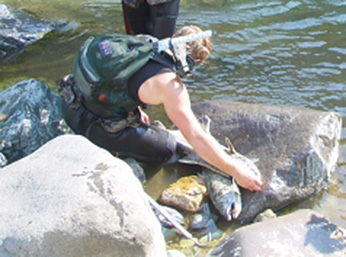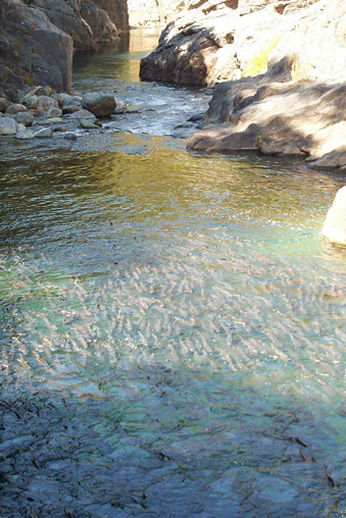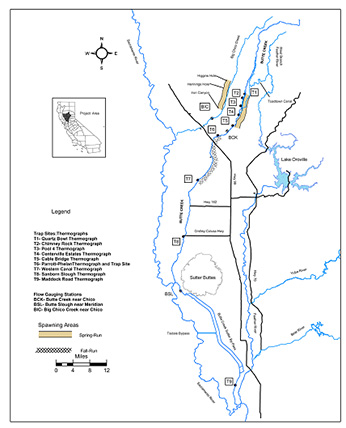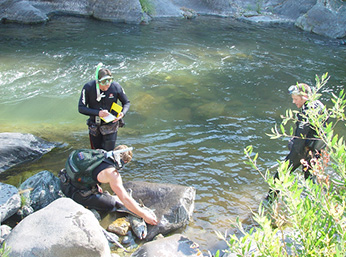(Butte Creek, Butte County)
Species / Location

 Figure 1. Adult salmon holding in a deep pool within the canyon portion of Butte Creek.
Figure 1. Adult salmon holding in a deep pool within the canyon portion of Butte Creek.
 Figure 2. Butte Creek watershed and salmon spawning locations.(click/tap to enlarge)
Figure 2. Butte Creek watershed and salmon spawning locations.(click/tap to enlarge)
 Figure 3. Biological data collection on a survey.
Figure 3. Biological data collection on a survey.
Butte Creek is one of only three Central Valley streams that continue to harbor a self-sustaining population of spring-run Chinook salmon (Oncorhynchus tshawytscha) (SRCS) (Figure1). The other two are nearby Deer and Mill creeks, located to the north in Tehama County. SRCS were listed as “threatened” under the California Endangered Species Act and federal Endangered Species Act in 1999. SRCS are anadromous, meaning that they hatch in freshwater, migrate to the ocean to mature, and return to their birth stream to spawn as adults. Uniquely, SRCS adults enter freshwater in the late winter and spring, spending up to eight months in streams prior to spawning. This extended fresh water residency requires that adults have access to suitable habitat--deep, cool, highly oxygenated pools--to survive high summer temperatures in the Central Valley.
Need for Drought Stressor Monitoring
Historically, SRCS populations were found in most of the eastern tributaries of the Sacramento and San Joaquin Rivers, and large dams and water development eliminated access to all but the few remaining self-sustaining tributaries (CDFG, 1998). With California experiencing an unprecedented drought this year, monitoring the health of the SRCS during their summer holding period in Butte Creek was a top priority for California Department of Fish and Wildlife (CDFW)(Figure 2).
Stressor Monitoring Efforts
Collaboration between CDFW, California State Water Resources Control Board, National Marine Fisheries Service, U.S. Fish and Wildlife Service and PG&E (Operations Team) to proactively manage water delivery and timing from the West Branch of the Feather River into Butte Creek played an important role in helping the SRCS cope with low flows and high water temperatures from the current drought conditions. Project reservoir storage capacity, potential water delivery scenarios and meteorological forecast of potential heat waves were discussed on a weekly basis. Group decisions were made each week based on environmental factors on how to adaptively manage the available water to best benefit the holding SRCS. CDFW personnel conducted weekly snorkel surveys of the entire holding habitat, an 11 mile reach of stream (Figure 3). Survey crews documented pre-spawn mortalities, determined fish distribution within the creek and documented any change in holding patterns over the summer period.
Findings
Monitoring for pre-spawn mortalities started on June 3, 2014 and continued until the start of spawning on September 18, 2014. A total of 115 pre-spawn mortalities were encountered. Seventy-five mortalities were measured and identified by sex; most of these mortalities (80%) were females. Determination of gender was important as reduction of the number of female salmon can substantially limit the number of offspring produced.
CDFW also monitored water temperature during the entire holding period to track changes in temperature based on the flow releases made from upstream reservoirs. Elevated creek temperatures in early July resulted in an increase in mortalities during the hot summer holding period, but mortalities reduced once ambient air and water temperatures lowered. Survey crews observed substantial movement of holding fish from the warmer waters downstream of the Centerville Powerhouse upstream to cooler waters. Early June snorkel surveys showed approximately 1,400 SRCS holding downstream of the Centerville Powerhouse.
By the end of August, only 440 SRCS remained in the pools downstream of the Powerhouse.
An intensive carcass survey was undertaken from September 23, 2014 to October 30, 2014 to estimate the number of fish that survived the summer to spawn. Preliminary results of the carcass survey indicate that nearly 5,000 fish successfully spawned in Butte Creek. The Operations Team’s collaboration coupled with real time adaptive management strategies of water releases contributed to the success of this year’s salmon population surviving the long hot summer drought and making it into the spawning season.
Future Efforts
Ongoing real-time monitoring of Butte Creek’s SRCS will continue each year to determine fish distribution, pre-spawn mortalities and behavioral patterns and how this information relates to PG&E’s DeSabla-Centerville Hydroelectric project. Continued coordination and collaboration within the Operations Team will play a vital role in ensuring that the returning future populations of Butte Creek SRCS will have the best chance at surviving and contributing to the overall resources of California.
References
- California Department of Fish and Game (CDFG). 1998. A Status Review of the Spring-run Chinook Salmon (Oncorhynchus tshawytscha) in the Sacramento River Drainage. Prepared by the California Department of Fish and Game, June 1998.
CDFW
Pacific States Marine Fisheries Commission
National Marine Fisheries Service
State Water Regional Water Quality Control Board
Pacific Gas and Electric Company